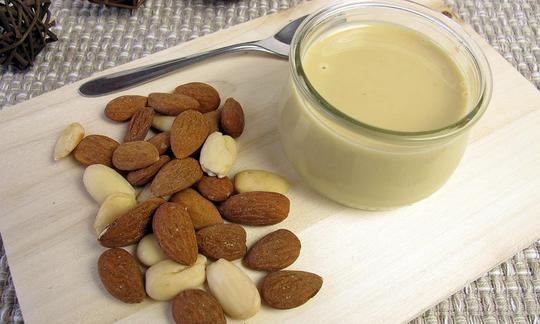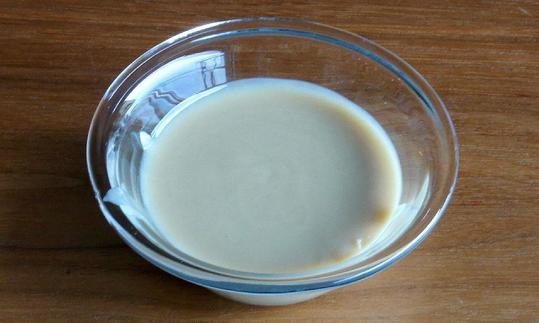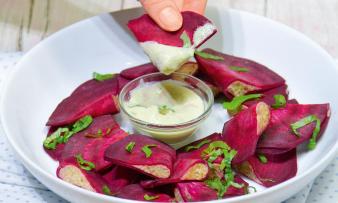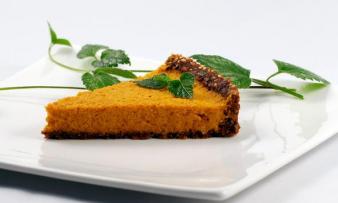Table of contents
White or light almond butter is used as a base in many vegan recipes. It usually consists of 100% peeled, finely ground almonds and, depending on how it is produced, is available raw and in organic quality .
Use in the kitchen
White almond butter can be used to replace cheese, eggs, butter or milk in many recipes. There are numerous dishes with almond butter, especially in vegan cuisine. Light almond butter consists of peeled almonds and tastes a little sweeter and milder than the darker butter, which usually consists of roasted almonds with skin. The consistency of almond butter can make stews or vegetable cream soups even creamier without being overpowering in taste.
It is suitable for baking, filling or spreading on cakes, muffins and cookies, refines sauces and dressings and forms a good base for sweet and savory spreads, dips and marinades. It gives smoothies, breakfast porridge and muesli with oat flakes a nutty note. When cooking oriental and Asian dishes such as curries or Thai soups, it can also be deliciously combined with stronger spices. White almond paste goes excellently with ginger and chili as a sauce for a vegan Pad Thai with tofu , is a binding ingredient in energy balls with Medjool dates and nuts such as almonds (sweet almonds) , hazelnuts or macadamia nuts (see recipe) and also tastes good as a dip with carrot sticks or oven-baked vegetables. It can easily be mixed with lemon juice to make a dressing and served with roasted aubergines , for example.
Making your own
White almond puree is easy and inexpensive to make yourself. For one jar, use 300 g of either peeled almonds or almonds that still need to be peeled. To peel them, pour boiling water over the almonds and leave them to steep for five to ten minutes. Then pour off the water and rinse the almonds with cold water. This process is called blanching. Blanched almonds are strictly speaking no longer raw. Alternatively, you can soak unpeeled almonds overnight and peel them the next day (using a knife if necessary), then they are still raw food quality.
If you put the almonds in a clean towel and rub them vigorously from the outside, the skin will come off most almonds. Once the almond kernels have been peeled, the production of light almond paste is completed in just a few steps. First, soak the peeled almonds in water for at least eight hours (preferably overnight). This reduces the phytic acid contained in the almond. Phytic acid binds important minerals in the stomach and intestines, so that the body can no longer absorb them. Read more about this in the text Phytic acid or phytate and soaking or sprouting .
Then pour away the soaking water, put the almonds in a high-performance blender and process them in several mixing phases to form a creamy puree. Between the individual mixing phases, use a dough scraper to push the mixture down again and again. The breaks should be at least ten minutes so that the oil can escape from the almonds. Finally, fill the finished almond puree into a screw-top jar.
Vegan recipe for energy balls with almond
butter Ingredients (for approx. 10 balls): 1 cup Medjool dates , ½ cup oat flakes (raw), ½ cup macadamia nuts and almonds (raw), 4-5 tbsp white almond butter (organic), 1-2 tsp cinnamon (optional), chia seeds for coating (optional).
Preparation: Put all ingredients, except the chia seeds, in a high-performance blender and chop to the desired consistency. Then mix these thoroughly with the almond butter in a bowl to form a smooth dough. Depending on the consistency, add a little more oat flakes or almond butter. Form the dough into bite-sized balls while it is still sticky. If necessary, coat the balls with chia seeds at the end. If necessary, moisten the balls with water beforehand so that the seeds stick better. Store the finished vegan energy balls in a closed container in the refrigerator (can or screw-top jar) and consume within a week.
Vegan recipe for green smoothie with almond
butter Ingredients (for 2 glasses): 2 bananas , 150 g spinach , 150 ml freshly squeezed orange juice , 1 tbsp light almond butter (organic), 1 piece of ginger (optional).
Preparation: Put all ingredients in the blender and mix until the desired consistency is achieved. Pour the finished vegan smoothie into glasses and enjoy immediately.
Vegan recipes with white almond butter can be found under the note: " Recipes that have the most of this ingredient ".
| Not only vegans or vegetarians should read this: Vegans often eat unhealthily. Avoidable nutritional mistakes . |
Purchasing - Storage
White almond butter is available from major retailers such as Coop , Migros , Spar , Aldi , Lidl , Rewe , Edeka , Hofer , Billa in the standard range or during special offers. Denner and Volg rarely have almond butter on offer. Organic supermarkets such as Denn's Biomarkt and Alnatura offer white almond butter in organic quality. White almond butter is also available online, often in larger quantities. Is almond butter cheap? The price of almond butter varies depending on the supplier. In any case, it is cheaper to make the butter yourself.
The availability of white almond butter varies depending on the size of the store, catchment area, etc. Our recorded food prices for the DA-CH countries can be found above under the ingredient image - and by clicking on them you can see their development at various suppliers.
Storage tips
Almond butter can be stored in a dry, cool place for several months. If an oily film forms on the butter, this is completely normal and can simply be mixed with the rest of the butter before use.
Ingredients - Nutritional values - Calories
White almond butter contains 670 kcal per 100 g. At 61 g/100g, it has a relatively high fat content and is a good source of protein at 20 g/100g. Carbohydrates are represented at 15 g/100g. The almond butter ingredients of white almond butter differ only slightly from the darker almond butter , which consists of unpeeled almonds. 1
Vitamin E , one of the most important nutrients in almond butter, is present at 18 mg/100g (147% of the daily requirement). The vitamin is mainly found in nuts, vegetables and fruits. Raw almonds (25.6 mg/100g) and hazelnuts (15 g/100g) also contain higher amounts of this vitamin, in contrast to peanut butter (6.3 mg/100g). 1,2
100 g of white almond butter contains 1.8 mg of manganese (90% of the daily requirement). Peanut butter has the same high levels. This important trace element is mainly found in the germ and the outer layers of grains. Pumpkin seeds contain almost three times as much manganese at 4.5 g/100g and oat flakes are also good sources of manganese at 3.6 mg/100g. 1,2
White almond butter also contains higher amounts of magnesium (263 mg/100g; 70% of the daily requirement). This essential element is involved in more than 300 enzymatic metabolic reactions and is mainly found in nuts and seeds. A similar amount is found in unsalted almond butter (279 mg/100g) and cashew butter (258 mg/100g). Peanut butter contains slightly less (160 mg/100g). 1,2
The complete ingredients of white almond butter, the coverage of the daily requirement and comparison values with other ingredients can be found in our nutrient tables. In the article Nutrients explained you will get a detailed insight into the topic.
Effects on health
Almonds ( Prunus dulcis var. dulcis ) are rich in vitamin E and polyphenols (secondary plant substances with antioxidant effects). Due to their ingredients, almonds have a blood pressure-lowering and cholesterol-lowering effect and can thus reduce the risk of cardiovascular diseases. However, since the secondary plant substances are mainly found in the skin, 3,4 it can be assumed that peeled almonds have a somewhat less pronounced antioxidant effect. The exact ingredients of almonds and their effects on health can be found in the article Almonds (sweet almonds), raw .
So far, only a few studies have looked into almond butter and its health effects. Daily consumption of 100 g of almond butter made from roasted almonds (with skin) has, among other things, a positive effect on lowering LDL (low-density lipoprotein) in the blood. 5 LDL is responsible for transporting cholesterol from the liver into the cells. If it remains in the blood, it changes its structure and leads to deposits on the artery walls, which lead to arteriosclerosis and heart disease. For further information, please refer to the article on the ingredient Almond butter, unsalted (raw?, organic?) . There is no current research on white almond butter.
Is almond butter suitable for losing weight? Due to the nutrients it contains, almond butter is extremely high in energy. It should therefore only be consumed in small amounts and with caution. We are not aware of any studies that have examined the effect of almond butter consumption on weight control. On the other hand, one study showed that consuming raw almonds curbed cravings for high-fat foods compared to an energy-rich alternative snack, but had no effect on reduced energy intake over 24 hours. 6 Subjects in another study who consumed a handful of almonds as a snack over four weeks reported no additional weight gain. The participants saved the calories they consumed through the snack at their main meal because they consumed smaller amounts there. In this respect, eating almonds can have a (pre-)satiating effect, but has so far shown no weight-reducing effect. 7
Is white almond butter healthy? The ingredients in almond butter are extremely valuable. However, compared to the darker variety, white almond butter contains less fiber, vitamin E and secondary plant substances due to the lack of skin in the processed almonds. As part of a balanced diet, consumed consciously and in small quantities, almond butter can definitely be described as a healthy food.
Dangers - Intolerances - Side effects
People who are allergic to almonds ( Prunus dulcis var. dulcis ) should be careful with both white and dark almond paste.
Depending on the method of production, blanched almonds are roasted in order to obtain a more intense flavour through the Maillard reaction that occurs. During the Maillard reaction, amino acids and reducing sugars are converted into new compounds at high temperatures. This means that the roasted, baked or roasted protein-rich foods have a more intense flavour. 8 However, undesirable Maillard reactions lead to the formation of the substance acrylamide, which is classified as carcinogenic, which it forms from the amino acid asparagine. 9 Asparagine is also found in almonds. The formation of acrylamide during the roasting process of almonds begins at 130 °C and increases more sharply at 146 °C. 10,11 Compared to hazelnuts, almonds contain a much higher content of free asparagine, which is why more acrylamide is formed during roasting. In addition to the concentration of free asparagine, the roasting temperature is the most important factor influencing the formation of acrylamide in almonds. 11,12 Information on the roasting process is usually not available on industrially produced almond butter, but can be found online on the manufacturer’s website.
Due to the high fat content and high calorie count, white almond butter should be consumed in moderation. Although almond butter is rich in unsaturated fatty acids, these contain high amounts of omega-6 fatty acids (linoleic acid; LA) and hardly any omega-3 fatty acids (alpha-linoleic acid; ALA). The human body must absorb both fatty acids through food. Excessive amounts of polyunsaturated omega-6 fatty acids and a very high omega-6/omega-3 ratio promote the development of numerous diseases, including cardiovascular diseases, cancer, and inflammatory and autoimmune diseases. 13 A ratio of no more than 5:1 (LA:ALA) is still considered desirable. Instead of a ratio, the Federal Nutrition Commission ( EEK ) now advocates absolute intake and recommends amounts of polyunsaturated fatty acids of 2.5-9% (omega-6 fatty acids) or 0.5-2% (omega-3 fatty acids) of daily energy requirements. This corresponds to a maximum of 20 g per 2000 kcal (omega-6 fatty acids) or 1-4.4 g per 2000 kcal (omega-3 fatty acids). 14
The intake of omega-6 fatty acids is significantly higher in vegans and vegetarians than in omnivores. As a rule, the ratio of omega-6 to omega-3 fatty acids is considered to be higher in a vegan (< 14:1-20:1) and lacto-vegetarian diet (< 10:1-16:1) compared to a mixed diet (< 10:1). 15 A high consumption of cashews, peanuts, hazelnuts, almonds, sunflower seeds, products made from them such as butter and vegetable oils can lead to an unfavorable ratio and promote inflammatory processes in the long term.
We can only warn: vegans and vegetarians who are misinformed or uninformed generally live worse than "normal eaters" - and a study is sure to come out that will ruthlessly expose this (see link in the box above). This could stop the vegan hype that is so important for animal welfare and the environment and discredit the oriented minority. This has been our fear since 2014! See this link to see what happened with raw food: The Giessen Raw Food Study .
Ecological footprint - animal welfare
The CO 2 footprint of a food depends on various factors. The type of agricultural production (conventional vs. organic), average or seasonal or regional production, domestic production or import by truck, ship or plane, different types of packaging and whether the goods are fresh or frozen all play a decisive role. 16
When buying almond butter, look for fair trade and organic certifications.
Worldwide occurrence - cultivation
Information on the origin, cultivation and harvest of sweet almonds can be found directly on the ingredient . With increasing awareness of healthy eating, especially in industrialized countries, the global demand for almond butter is also increasing. In 2022, Europe had the largest market share. The countries with the highest consumption include the USA, Canada, the United Kingdom, France, Germany, China, India, Japan, Brazil and South Africa. 17
Industrial production
Industrial production differs slightly depending on the supplier, but basically follows the same process as in-house production. For white almond puree, the almonds undergo a blanching process after harvesting and quality control, where they are separated from their skin. The almond kernels are then crushed and dried to remove any residual moisture and then gently ground into the actual puree. Some producers roast the almonds to give the almond puree a more intense flavor (Maillard reaction). However, some manufacturers also use gentle roasting processes at temperatures below 42 °C.
Further information
The cultivated almond or edible almond ( Prunus dulcis ), the rock almond or sweet almond ( Prunus dulcis var. dulcis ), with its sweet-tasting kernel, also belongs to the rose family.
Alternative names
In English, light almond butter is called "blanched almond butter" or "white almond butter".













Comments